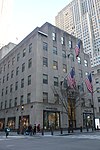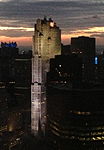Feagin School of Dramatic Art
AC with 0 elementsDrama schools in the United StatesEducation in New York CityNew York City stubsUniversities and colleges in New York (state) ... and 1 more
Use mdy dates from March 2022
The Feagin School of Dramatic Art (also Feagin School of Dramatic Radio and Arts) first located at Carnegie Hall, then later at 316 West 57th Street in New York City, was an early training site for notable actors including Jeff Corey, Helen Claire, Angela Lansbury, Alex Nicol, and Cris Alexander. It was later relocated to the International Building at Rockefeller Center.The school was founded by Lucy Feagin.
Excerpt from the Wikipedia article Feagin School of Dramatic Art (License: CC BY-SA 3.0, Authors).Feagin School of Dramatic Art
5th Avenue, New York Manhattan
Geographical coordinates (GPS) Address Nearby Places Show on map
Geographical coordinates (GPS)
| Latitude | Longitude |
|---|---|
| N 40.759166666667 ° | E -73.978055555556 ° |
Address
International Building
5th Avenue 626-636
10111 New York, Manhattan
New York, United States
Open on Google Maps










